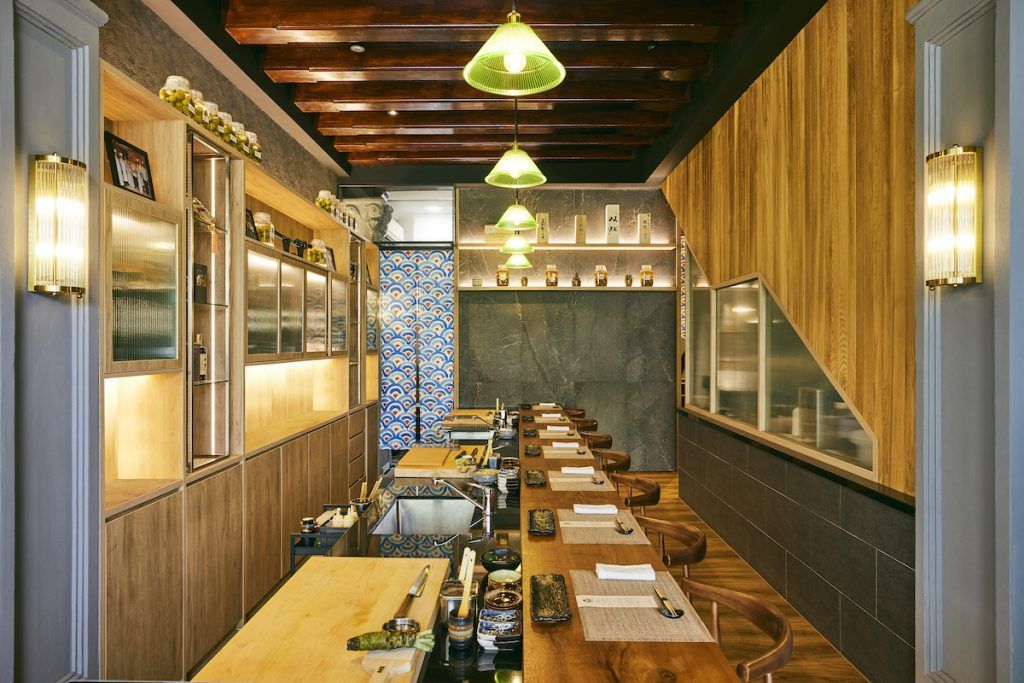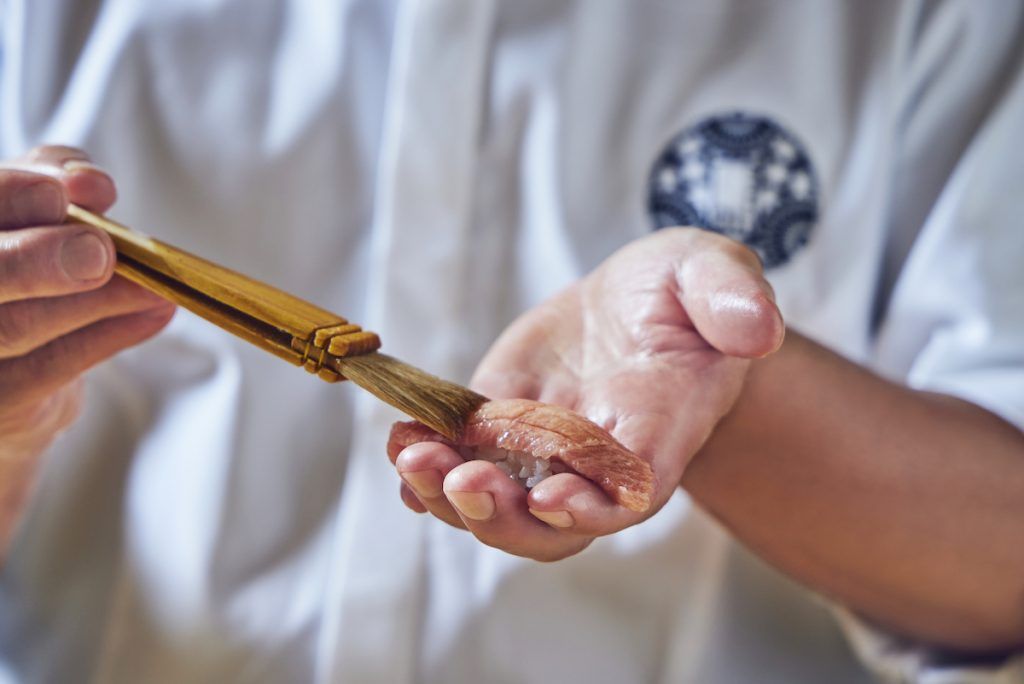Physician and foodie Caroline Low-Heah reviews Nijuuichi, the newest omakase restaurant in town serving original Tokyo-style sushi in an ultra-cosy, near-private ambience.
Sitting pretty on a slope among heritage shophouses at 21 Duxton Hill is an unassuming door that leads into Nijuuichi, a Japanese omakase restaurant serving Edomae sushi.
This style of sushi-making refers to the traditional preparation methods pioneered in the capital city in the Edo era, when there was no refrigeration, and hence seafood from the Tokyo Bay area was preserved through various methods to maintain freshness.
Featuring an L-shaped bar counter seating only 10 patrons and a private room for seven, this new kid on the block is helmed by chef Marcus Yan, who has over 30 years of experience and is a disciple of the renowned shokunin Yosho Nogawa. Among the many luminaries who have graced his table include Sultan of Johor Ibrahim Iskandar and the late Prime Minister Lee Kuan Yew.
Adorning the shelves high up against the walls are jars of homemade Wakayama plum umeshu – the youngest only a couple of months old, while the oldest, a good few years. Start with some liquid gold on the rocks while pondering your omakase choice. The menu is short and self-explanatory. For lunch, Nijuuichi offers a $128++ sushi set, and two menus with varied courses priced at $158++ and $208++. For dinner, there are two nine-course menus, Umi and Yama, priced at $288++ and $368++ respectively. I choose the Yama set.
A quick conversation with the maestro reveals a menu that changes with the seasons. Fresh fish is regularly flown in four times a week from Osaka and Toyosu Market (formerly known as Tsukiji Market) in Tokyo.
The cold appetiser arrives promptly. On a plate sits two bowls: one containing grilled kinoko mushroom in oroshi ponzu (ponzu mixed with grated daikon), and the other a dollop of corn tofu with plenty of promise. The marinated mushroom’s acidity is well balanced by a long sweetness, and the tofu delivers a creamy texture with the crunch of corn with every bite.
The second course is well presented with kanpachi (amberjack) carpaccio, with each slice of fish topped with caviar and uni. The truffle and sesame oil marinade is a good marriage of nuttiness in a forest of lingering wood. Following that is flounder, otherwise known as hirame, which is sliced thinly and rolled into a tight cigar with bannonegi (a type of spring onion), offering a tart finish when dipped into ponzu.
An all-time favourite among sushi lovers is shima-aji (striped jack fish), served two ways here: with a pinch of wasabi, and with yuzu kosho (a fermented condiment paste made of chillis and yuzu). All that is needed is a dip of plain shoyu. The peppery yuzu kosho delivers a numbing spiciness and somewhat satisfying finish.
After the three oily fish from the cold sea, whelk from Hokkaido makes its appearance in a form of sashimi topped with tosazu jelly. The crunchy whelk and the acidity from the bonito-infused sweetened soya sauce vinegar jelly cuts the oiliness from the last few dishes, resetting the palate for more pleasure.
After the cold dishes, the journey is now heating up. Next on the list is tachiuo, a belt fish from the Ehime prefecture, which is ever so lightly aburi-ed, served with a garlic, ginger flower and sweet shoyu sauce, and garnished with radish sprouts. Ainame fish, a greenling from the town of Taiji, is simply deep-fried and served with a sweet daikon shichimi togarashi sauce made with a Japanese spice mix. The dashi used to make the sauce perfumed the tastebuds, giving the dish a long, sweet finish.
There is a most unusual twist to the next dish: the no-rice sushi, aka tai tai sushi. This will have a strong following from the ladies who lunch. Saba is marinated in shoyu for 30 minutes, rolled into a maki with a filling of pickled ginger, shiso leaf, pickled daikon and menegi (green onion bulb). The fatty fish is complemented by the acidity of the pickles and the freshness of the shiso. One should ask for seconds.
Toro (tuna) lovers will enjoy the next three dishes. Otoro cut from the neck of the fish, known as kama toro, is simply presented. Glistening in its own oil, it is best eaten in its naked form. A cut found on the back and belly of the fish, chutoro, provides a lighter but slightly bitter taste, and is contrasted by the earlier sweet tenderness of the otoro. The last of the trio is a piece of otoro smoked in straw.
The peaty aroma fills the nose and each bite is like cutting through soft butter, except better. It is advisable to complement this dish with a dram of whisky – Japanese, of course.
Despite the stomach not keeping up with the eyes, it is impossible to resist awabi (abalone from Hokkaido), which is steamed for three hours, served with awabi sauce and topped with aonori (green laver). An explosion of rich and creamy flavours hits the roof of the mouth with every morsel. A side request of a small dollop of sushi rice elevates the dish to hit a most satisfying spot.
More to come are the sushi of nodoguro (blackthroat seaperch), kuruma ebi, and kamasu (a barracuda from Toyama) served with mentai. Engawa, the dorsal fin of the hirame, which is served aburi-style, provides the much-needed bite; and shoyuzuke-style (soya sauce-pickled) chutoro ends this sushi ensemble.
Just when one thinks the omakase is concluded, the restaurant’s signature Trinity Rice Bowl – a medley of negitoro, uni and ikura with bits of seasoned radish served on hot rice – makes its appearance. All mixed up, it is umami crunch in a bowl. Once the fish collagen soup with prawn ball is dished up, one realises this meal is sadly ending. No Japanese meal is complete without matcha ice cream and refreshing musk melon – the desserts are an ideal finale to a perfect culinary journey.
This story first appeared in the September issue of Prestige Singapore
Yes, I agree to the Privacy Policy
Thank you for your subscription.
Subscribe to our newsletter to get the latest updates.
Thank you for your subscription.